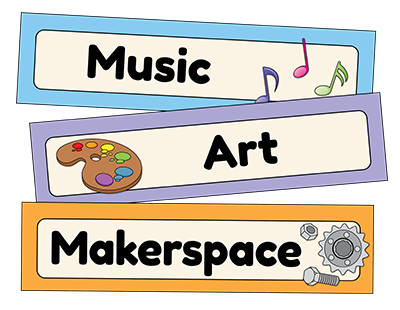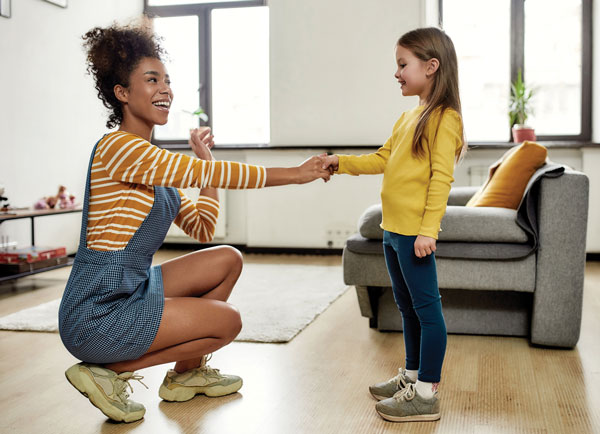 The start of another year in childcare or preschool can bring about nervousness in young children, even if they are returning to the same setting or continuing care with the same teacher. If your setting does not close for the summer, children’s enrollment may have varied because of family vacations or a parent’s adjusted work schedule. Some children may be unsure about who will be returning to preschool or childcare with them in the fall. This post outlines 10 tips to support new and returning children in settling into a new routine. Use these tips to help everyone feel welcome and ease transitions!
The start of another year in childcare or preschool can bring about nervousness in young children, even if they are returning to the same setting or continuing care with the same teacher. If your setting does not close for the summer, children’s enrollment may have varied because of family vacations or a parent’s adjusted work schedule. Some children may be unsure about who will be returning to preschool or childcare with them in the fall. This post outlines 10 tips to support new and returning children in settling into a new routine. Use these tips to help everyone feel welcome and ease transitions!
- Start with a clean space.
 Take inventory of what is in your setting and the types of materials you are offering. Reflect on areas of the room that may frequently pose challenges (e.g., areas where children may find it hard to share or run around) and plan to make adjustments to better accommodate the children’s needs. Repair or replace broken items and refresh materials as needed. Clean floors and carpets.
Take inventory of what is in your setting and the types of materials you are offering. Reflect on areas of the room that may frequently pose challenges (e.g., areas where children may find it hard to share or run around) and plan to make adjustments to better accommodate the children’s needs. Repair or replace broken items and refresh materials as needed. Clean floors and carpets.
- Label cubbies, cots, and any other spaces/items unique to each child. You may already embody this practice, however, labeling materials before children arrive is like offering a welcome sign. The children and their families will know where to store their belongings and begin to feel some ownership of their experience in the space.
- Designate a family wall. Designate a wall or bulletin board for family sharing. Invite families to share photos, invitations, announcements, and other information about themselves. You may need to offer prompts early on about what families should post; ideally, families will feel comfortable managing this space on their own over time.
- Establish a routine.
 Children respond well to consistency and knowing what to expect. It is likely that you have a daily schedule. Review the schedule with the children and help them understand the routines that comprise it. Include pictures of each activity so children can follow along easily. Refer to the schedule often as you prepare for transitions. Explain in advance when there might be a change.
Children respond well to consistency and knowing what to expect. It is likely that you have a daily schedule. Review the schedule with the children and help them understand the routines that comprise it. Include pictures of each activity so children can follow along easily. Refer to the schedule often as you prepare for transitions. Explain in advance when there might be a change.
- Take a tour. Whether the children in your care are new or returning, take a tour of the classroom and extended environment together. First, highlight spaces where the children settle in such as the cubby area. Next, show them the different learning and play spaces. Show the children where the bathroom is and sinks for handwashing. If you are in a large center facility, take the children to the director’s office, up and down the main stairwells, and to the outside and/or indoor gross motor area.
- Review and teach expectations. Children come into our care with different levels of understanding and from diverse backgrounds. Some may have more knowledge of expectations in a preschool or care setting than others. Explain expectations for each area of your setting or routine. Model each expectation for the children and actively teach it. You can use social stories to address and teach specific skills or you can start by referencing an expectation matrix.
- Set up exploration stations or learning centers.
 Designate areas where children can engage thoughtfully with activities. Choose activities that are open-ended and encourage focus. Common station or center activities include pretend play, blocks, science or STEM, art, and books. As children enter your setting, invite them to choose an area to play in. Stations or centers can also be spaces where parents or caregivers play and learn alongside their children during drop-off or pickup.
Designate areas where children can engage thoughtfully with activities. Choose activities that are open-ended and encourage focus. Common station or center activities include pretend play, blocks, science or STEM, art, and books. As children enter your setting, invite them to choose an area to play in. Stations or centers can also be spaces where parents or caregivers play and learn alongside their children during drop-off or pickup.
- Choose diverse books. Offer books that reflect the cultures and values of the children and their families. Consider “windows and mirrors” as you select books: Ask, “Can my children see themselves in these books? Are they learning about each other and other cultures through this selection?”
 Get to know each other through games and songs. Welcome children with a name game or song. Invite children to stand up by letters of their first names, or have them stand or sit in a circle and bounce or roll a ball to each other. The child receiving the ball should say her name for everyone. You could also chant “Hicklety, Picklety, Bumblebee”:
Get to know each other through games and songs. Welcome children with a name game or song. Invite children to stand up by letters of their first names, or have them stand or sit in a circle and bounce or roll a ball to each other. The child receiving the ball should say her name for everyone. You could also chant “Hicklety, Picklety, Bumblebee”:
Hicklety, picklety, bumblebee,
Won’t you say your name for me?
Liam! (loudly)
Liam. (whispered)
Li-am. (mouthed without vocalizing)
- Invite children to be vocal. Finally, one of the best ways to help children settle in is to encourage them to be vocal. Seek out their likes/dislikes and needs/wants. Invite them to select books or help in making decisions about the room arrangement. Invite them to take ownership of the space. This will not only make them feel comfortable and support settling into a new routine, it will also encourage responsibility, camaraderie, and problem-solving.
Back to blog listing